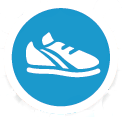One pound of muscle burns three times as many calories as one pound of fat, so your metabolism takes a nosedive as muscle mass declines.
YOUR OWN BODY WEIGHT
Push-ups, plank, squats, lunges, sit-ups, yoga.
Using your own body weight for resistance is a classic way to build muscle. Most exercises in this category use multiple muscle groups for a more complete workout. Plus, these exercises can be done anywhere. As you grow stronger and lose weight, these exercises will become easier so you’ll need to increase repetitions to keep them effective.
RESISTANCE BANDS
Leg lifts, arm raises, pelvic push.
Resistance bands allow you to build muscle with a full range of motion, not just up and down, and you can use them for building flexibility. You don’t strengthen a muscle, you strengthen a movement. Plus, bands are small and portable. It will take a little time to learn various ways to use the band. Be prepared to upgrade to bands that offer greater resistance as you grow stronger.
FREE WEIGHTS
Bicep curls, chest press, weighted squats.
Free weights have more variety in weight increments so you can progress faster. You can also target a specific area you want to focus on. Free weights include dumbbells, barbells, kettle bells, and homemade weights like milk jugs filled with water or sand bags. While free weights offer the quickest avenue for results, they also have the greatest risk for injury, so be sure to use proper techniques.
MACHINES
Chest press, leg press, hamstring curls.
Machines give you support while you lift weights—something very beneficial to anyone with an injury or a beginner who is still mastering correct form. Machines are simple to use; they are less confusing than a rack of dumbbells or a resistance band. They target fewer muscles at a time and movements are limited. They are large and expensive. Most people use them at a gym.

TIPS FOR BEGINNERS
- Strength train twice a week, but be sure to take at least a day off between sessions.
- Warm up with a few minutes of cardio first.
- Push yourself—you won’t gain any muscle if you quit when it gets hard
- Feeling discomfort in muscles is okay. Discomfort in joints is not.
- If you have injuries, pain, or physical limitations, hire a professional to teach you proper techniques before embarking on strength training on your own.
- Perform one set of 10 reps of an exercise using light weight.
- After two weeks, increase your weight and the amount of reps.
- Maintain good posture.
- Lift and lower weights slowly .
- Stretch after every workout to reduce soreness and increase flexibility.
- Eat lean protein within an hour after every workout, like a chicken salad or a ProFlex® protein shake.
YOUR FUTURE S TARTS NOW
So the message is pretty clear: Regardless of your age or shape, the time to start strength training is NOW. You need strength in so many areas of your life beyond the confines of formal exercise—hoisting kids, lifting groceries, putting bags in the overhead compartment on a plane. Strength training gives you the energy and, well, the strength to enjoy life and all the gifts it has to offer. There are dozens of reasons to maintain muscle mass, but there’s only one that really matters—the quality of your future life depends on what you do now. You’re worth the time and effort. So no more excuses. Start today.
WITH STRENGTH TRAINING, YOU’LL ENJOY:
- A faster metabolism
- A better immune system
- Better posture
- Improved flexibility
- Better balance
- Less arthritis pain
- Increased bone density
- Lower risk of diabetes
- Improved mental outlook
- Better sleep quality
- Better blood sugar control
- Lower risk of heart disease
- Joints that are better protected from injuries
- A toned, sexy physique




